Sponsored By Garmin
WHAT IS STRUCTURE AND WHAT IS COVER?
The underwater world is a marvelous yet complex realm. Ocean, lake, river, and pond beds are made up of mostly natural elements carved out over thousands of years consisting of either geological materials or vegetation. Yes, there are man-made elements down there as well such as bridge pilings, cribs, oil rigs, shipwrecks, sunken artificial reefs, sunken brush piles, and the list goes on. To anglers they can all be categorized as one of two things, structure, or cover, but which is which.
According to most experts, the answer is quite simple, structure is considered to be part of the substrate or bottom of the water body while cover is anything above it. We asked the Fish’n Canada guys to elaborate, and this is what they said: “A lot of people confuse the two but really it’s quite simple, structure shows up on a map as contour lines, cover doesn’t!” At the end of the day, it really doesn’t matter what you call it as long as you realize just how important of a role structure and cover play in a fish’s life.
We also asked Gord Pyzer host of “Fish Talk with the Doc” he confirmed what Ang and Pete said, “Structure is anything relating to the bottom. A shoal on the bottom coming way up or a drop-off. That’s structure. A weed bed isn’t structure. A weed bed is cover. A dock on the shoreline, that’s cover. A fallen tree on the shore or underwater submerged stumps. Those are all cover.
Thanks, boys!
Years ago, Elwood “Buck” Perry, the forefather of “Structure fishing” and “spoon plugging”, theorized that fish used these natural and man-made elements to travel to and from feeding grounds.
Today we know that fish use structure and cover not only to feed, but also to rest, spawn, and hide. Nothing will affect where fish will be at any given time more than structure and cover.
A PICTURE IS WORTH A THOUSAND WORDS
The following images are a simple but effective way to show just how important structure and cover are to a fish.
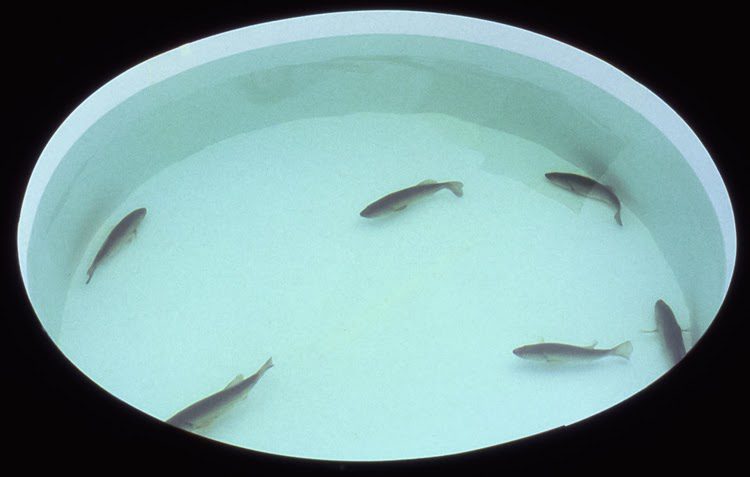
In image #1 above, you see a container of water with nothing else but fish in it. It has no cover or structure. The fish are all swimming around aimlessly or randomly. Imagine this in a huge lake… where would you start to fish???
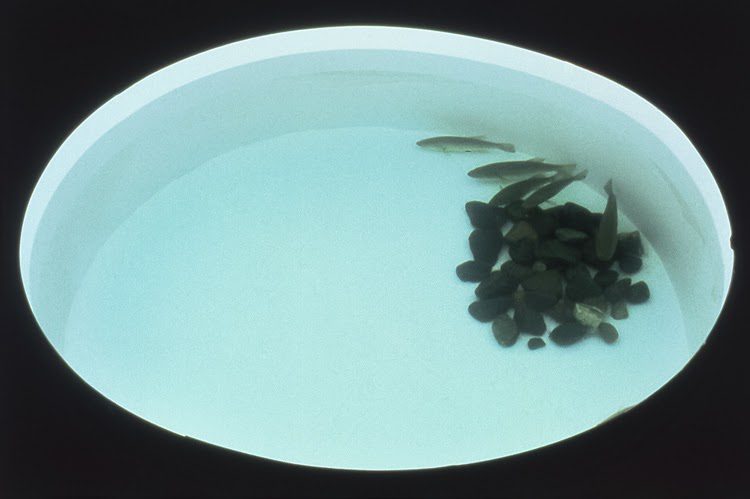
In image #2 above, imagine these pebbles and stones as a hump or a point. Just like a magnet, it immediately draws all the fish to it.
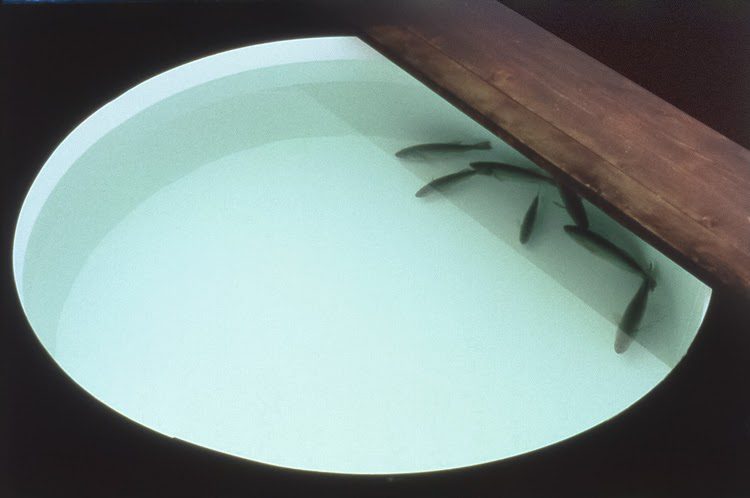
In image #3 above, a piece of wood was placed over part of the pool. Every fish took advantage of the overhead cover.
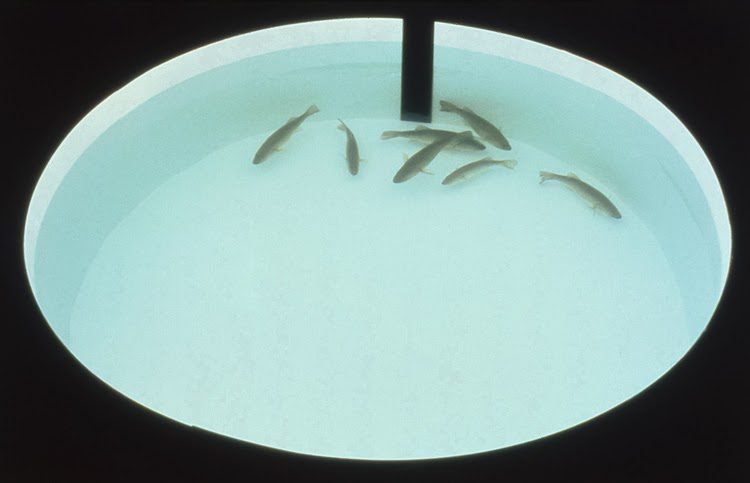
In image #4 above, a simple piece of black electrical tape was affixed to the side of the pool. Amazingly all the fish were attracted to this dark line. This example could be defined as either structure or cover.
LET THE TOP 10 COMMENCE
The following 10 are SOME of Pete and Ang’s favourite types of structure and cover to look for and fish. They picked four in the form of structure, and six in the form of cover.
STRUCTURE:
struc·ture
Noun: areas where there is a variance in the depth or the contours of the bottom, and these changes can range from subtle to dramatic
STRUCTURE #1 = BREAKLINES
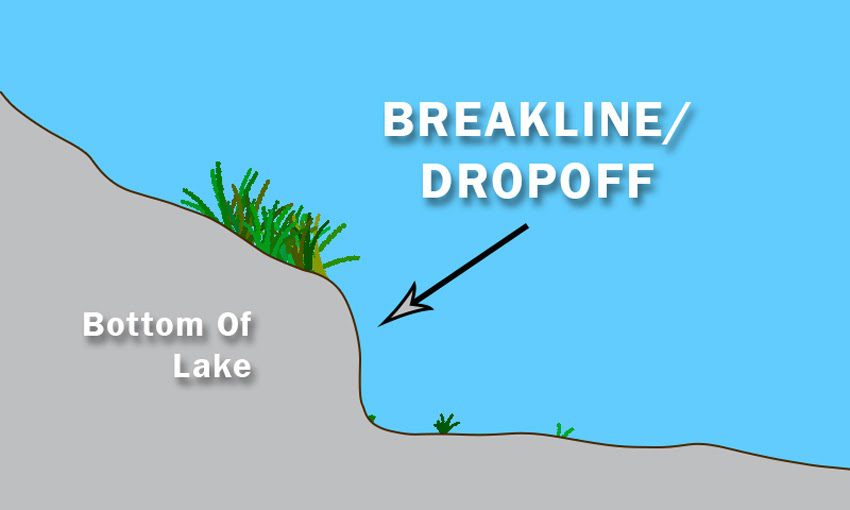
Breaklines, or as they are often referred to as drop-offs, are a critical type of structure that are found on every body of water. They are areas in which the bottom goes from shallow to deeper (or vice versa depending on where you are situated on a waterbody). A breakline may be as little as 1 foot, or it could be a massive drop from shallow to deep.
Breaklines are often on hard bottoms (rock as an example) but they can also be situated in softer bottoms like mud for instance.
Fish use breaklines for their daily routes to feed, spawn, rest etc. We like to compare underwater breaklines, to roads or trails in our above-the-water world. Would you, as a human being, walk through thick, hard to penetrate bush vs. a clean-cut trail. The answer under normal conditions is no. We would all take the easy route. Well fish do the same thing with breaklines. Once they have established where they are going and what for, they will time and time again use a breakline or drop-off as their guide.
STRUCTURE #2 = TRANSITIONS
A transition in the world of fish habitat is exactly as it sounds; it is a spot where one type of structure or cover meets up with another. Classic examples of fishing transitions would be where rock meets sand, where sand meets clay or even when a hard clean bottom meets a weedy softer bottom (combination of structure and cover).
These transitions often resemble the same highway or path that the above-mentioned breaklines do in where the fish can use it as a guideline to follow throughout its daily movements.
We absolutely LOVE fishing transitional areas.
“Transitions are one of those givens,” says Ang “in that once we find them, it’s then an all-out effort to further explore and ultimately find that sweet spot that holds the fish.”
“A perfect example” continues Ang “is where two different rock types meet. I’ve seen many rock flats (plain, smooth, etc.) that meet up with a massive group of boulders or rocks. It is spotted like this, where my fish radar goes crazy!”
Once we find the transitional areas… it is game on!
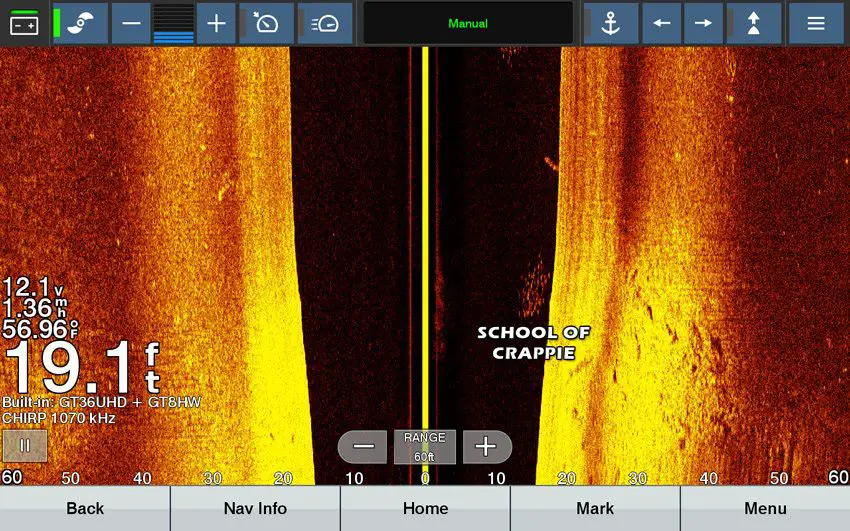
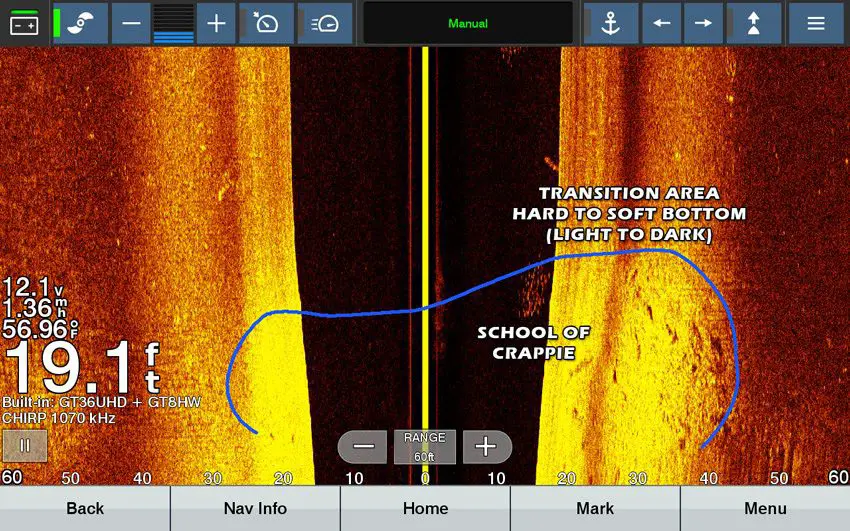
In these Garmin SideVu screenshots, you can see in the second image where we have marked with a blue line, the bottom transition from one type to another. In this case, the brighter to darker shades indicate a harder to softer bottom. As well you will notice the school of Crappie sitting almost exactly above that transitional area. That is not by chance. It happens all the time.
The beauty of looking at screenshots like this is you get to see what is going on deeper in the water where the human eye cannot see. If this were a shallow, clear water area, that transition might be physically visible to the human eye. By being in deeper, somewhat dingier water, the only way to see these transitions is with your sonar unit.
STRUCTURE #3 = SAND
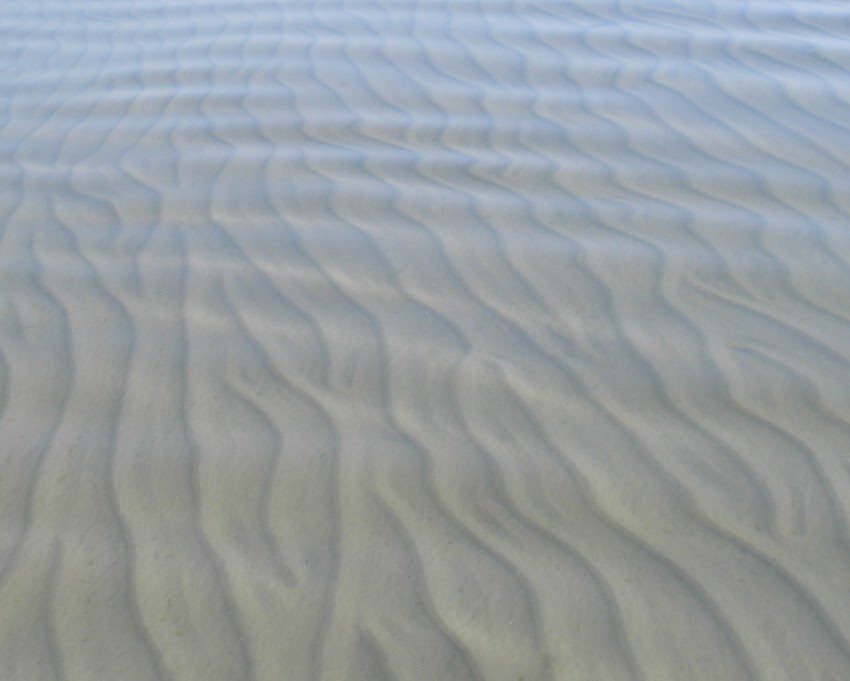
What the heck are we doing looking for sand when fishing? Like… are the fish in “beach-mode”?
Well, our sun-worshipping friends, believe it or not, some fish love being in sandy areas. So often we have found Smallmouth Bass, Northern Pike, Walleye, Lake Trout, etc. on sand-bottomed areas.
What is it about sand that attracts fish?
Well, to us it seems like the perfect “hunting” zone in that it is usually a wide-open, flat expansive area. If you were to look at it like a cheetah stalking its prey on the open range, it would be a much easier task for the speedy predator to out-run and take down an antelope for instance, than it would be in a heavily wooded area.
In the fish’s case, a Smallie or Walleye could easily spot, chase, and hopefully capture a delicious little Perch in an open, sandy area.
More often than not though, you should try to look for the proverbial “spot within a spot” when fishing sand. A big flat is good, however, a patch of weeds, a few rocks or boulders or even a sunken log within the sand is that much better. It provides a place for either baitfish or gamefish to hide in… both are good scenarios.
“Here’s a basic tip” says Pete “for fishing sand in relatively shallow water, but one that is a must. Use your eyes to their maximum potential here. Polarized glasses and a good pair of eyes will often save your day when fishing sand. Not only is it easy to find those little hotspot-type areas as mentioned above, but it is also ultra-easy to spot fish like Smallmouth Bass. They show up like crazy when the ambient light is right. See the fish, cast to it, and hope for the best!”
STRUCTURE #4 = HUMPS

An underwater hump is exactly what it sounds like. It is simply a rise from the bottom but doesn’t break the surface like an island. They are often referred to as “underwater islands”.
Humps are probably our absolute favourite types of structure to fish. It is actually harder to find a mid-lake hump that does not hold any fish than one that does (bold statement, we know).
Humps are a multi-species mecca. They can have Largemouth, Smallmouth, Walleye, Pike, Muskie, Lake Trout, Rainbow Trout, Burbot, etc.
We love finding a hump with our sonar units, especially on uncharted waters. Once we isolate these underwater islands we’ll usually create our own map with the Garmin “Quick Draw” feature, then we dissect it and look for the primary contact points with some hopefully a bit of lead in cover and bingo, we’re in catch mode.
COVER
cov·er
Noun: anything which is situated “upon” the bottom of a lake or river but is not “part of” the actual structure of the bottom.
COVER #1 = WOOD (NATURAL)
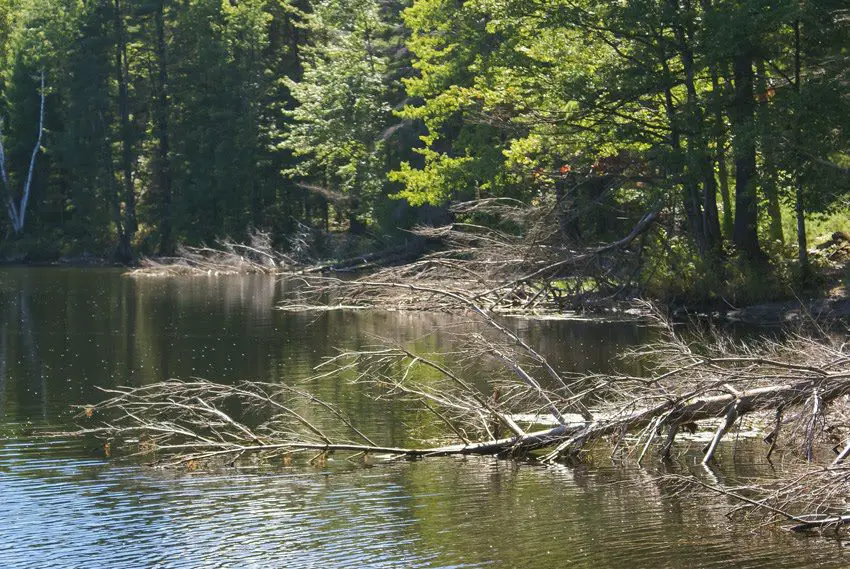
Wood in the form of cover for fish is simply put, AWESOME!
Wood comes in so many natural forms like fallen trees, stumps, sunken logs, and so on.
It also comes in man-made forms (see below) like docks, swim rafts, cribs, etc.
The beauty of wood is that it provides a multitude of needs that a gamefish could desire.
First off, once wood is established in an underwater environment, it starts to become “alive”. It is indeed odd to see something as dead as an uprooted tree, morph into an aquatic feeding station. Well, that is what happens through time. Algae = zooplankton = bait = biggies!
Secondly, wood provides cover from all angles. The obvious is overhead, with branches everywhere. However, in the case of a sunken log, a fish can cozy right up alongside this wonderful protector and hide from predators or become that predator in sniper mode.
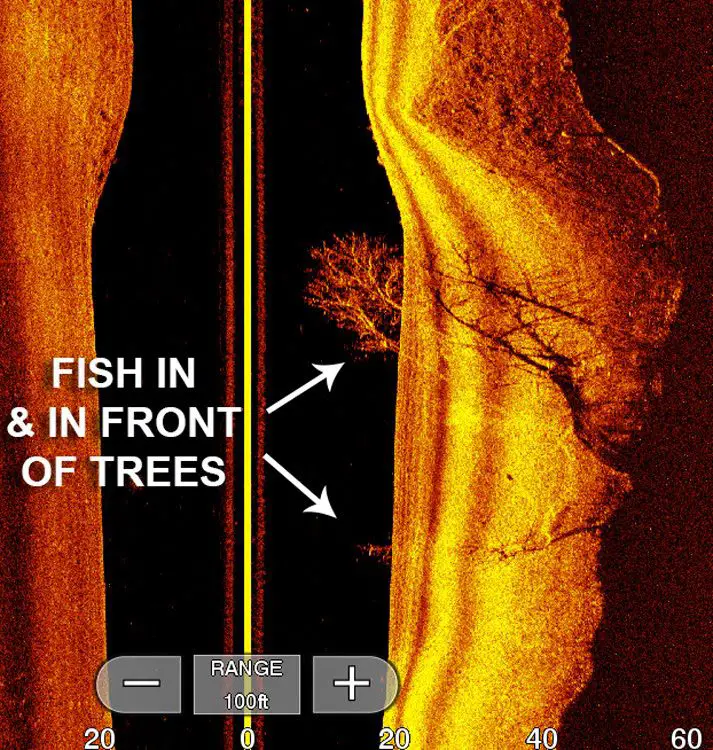
As you can see with this Garmin EchoMap screenshot (cropped in to give you a closer view), fallen trees can and do extend well out into the water. Often from a boat, they fade from view into the depths and anglers do not see the full extent nor do they take advantage of it. By using modes such as SideVu, ClearVu or LiveScope, these branches are a breeze to find and ultimately fish.
BTW when you become an expert on your electronics, you will be able to tell if there are fish in the trees or it is time to move on and check another piece of cover.
ULTIMATELY: WOOD IS GOOD!
COVER #2 = DOCKS
If WOOD IS GOOD, then DOCKS ROCK!
Docks are not just made from wood. There are a lot of metal and plastic floating docks as well. And regardless of what “they say (I only fish wood docks with blah blah blah)”, all these examples can hold fish.
Ultimately if we were to only pick one dock material it would be wood. This is because of the same reasoning as with natural wood; the perfect materials to grow fish-food. We will, however, fish all types.
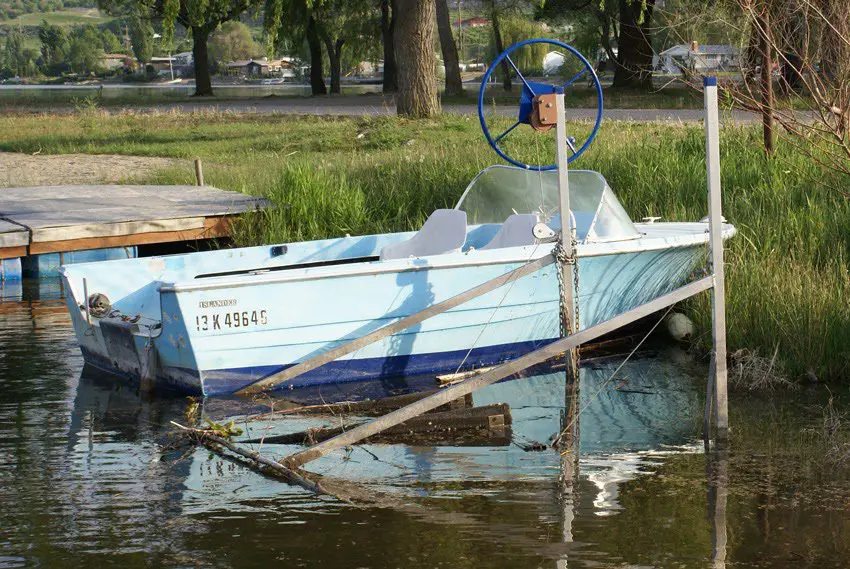
This is a good-looking area for Largemouth. There is a dock in the background, the old boat next and a boat lift covered in slop. It looks grody, it looks gross, it looks nasty, but trust us, fish this kind of area thoroughly!
What makes a dock special ultimately boils down to attracting bait. If there is an ample amount of bait around (baitfish, panfish, crawfish etc.), then any dock in the vicinity will be better than docks with no bait around. That means that even if a dock looks perfect to us as humans, it could get its butt kicked by the ugliest dock on the lake if the baitfish ratio is 10 for the ugly, and 0 for the pretty.
“One thing we always look for,” says Ang “is what’s called lead-in cover. This is where something like a weedbed or clump of weeds grows relatively close to the dock. That way a fish can travel in and out of the weeds, and back and forth to the dock. Look at it as an extra room in a fish maze.”
Although docks are thought of mostly for Largemouth Bass, we’ve caught Smallmouth, Pike, Muskie and even Walleye under docks.
COVER #3 = WEEDS

Weeds are the ultimate in cover. They exist in almost every body of water, and fish of every type seem to love them. There are very few bad weeds, fish seem to love about 80% of the weed types in most freshwater lakes.
Some of the best are cabbage, milfoil, lily pads, arrowheads, reeds, and coontail.
Fishing weeds can be a daunting task and it takes a lot of practice to get good at it. Slow reeling a crankbait for Pike is a 180-degree turn from dunking a jig for Largemouth. Trolling an edge for Rainbow or Brook Trout is much different than rip-jigging for Walleye. Weed fishing is a complex sport but at the end of the day weeds attract a lot of fish.
COVER #4 = ROCK
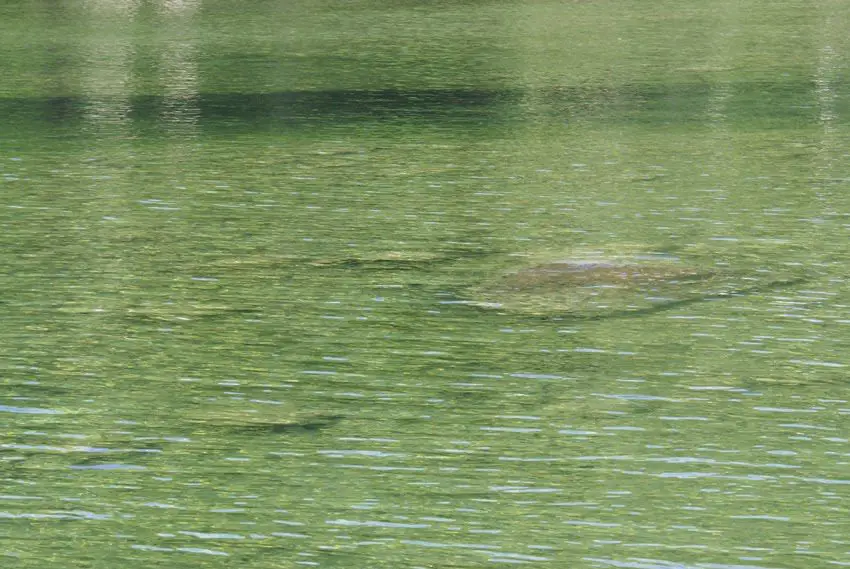
Rock is one of the most significant or prominent of all fish-holding types of cover (remember structure is the bottom, a rock sits on the bottom). It can be in the form of boulders anywhere from house-sized (or bigger) and all the way down to pea gravel.
In a river, a rock plays an important role in breaking current creating a perfect place for a Trout to hide.
In a lake, a single boulder is an awesome place for Smallmouth Bass to set up a nesting site and temporarily rear their young.
A gigantic pile of rocks like the one in the Minas Basin of the Bay of Fundy is a major feeding area for tide-influenced Striped Bass.
Rock walls or cliffs are the perfect areas on the St Lawrence River for Muskie and Smallmouth to hide against when in hunting mode, or simply for a resting area.
Rock is also the primary area for crawfish to live in. Find the rocks and find the bait.
COVER #5 = CRIBS
Cribs could be one of the best forms of manmade cover…
Cribs are one of those awesome man-made fish attractors that not everybody targets. When you think about it though, it is made of wood and rocks… both on this list.
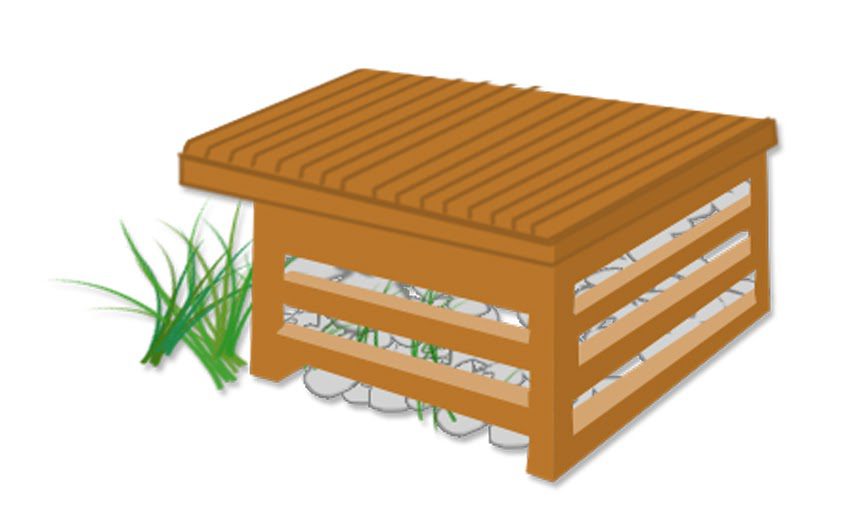
The primary fish species we target here are Largemouth and Smallmouth Bass however we have done surprisingly well on Muskie (maybe they’re in there eating the bass) too.
Any plastic bait will pick apart a crib quite nicely but if you are after Largemouth, a Jig & Craw or chunk is pretty hard to beat. More than likely there are some crawfish living in the area due to the buildup of rock inside the wooden “box”. If a Bass is living there, it’ll probably hit quickly.
If a jig doesn’t work, throw in a weightless soft stick worm like a Senko.
COVER #6 = MATTED GRASS OR DEAD OVERHEAD WEEDS
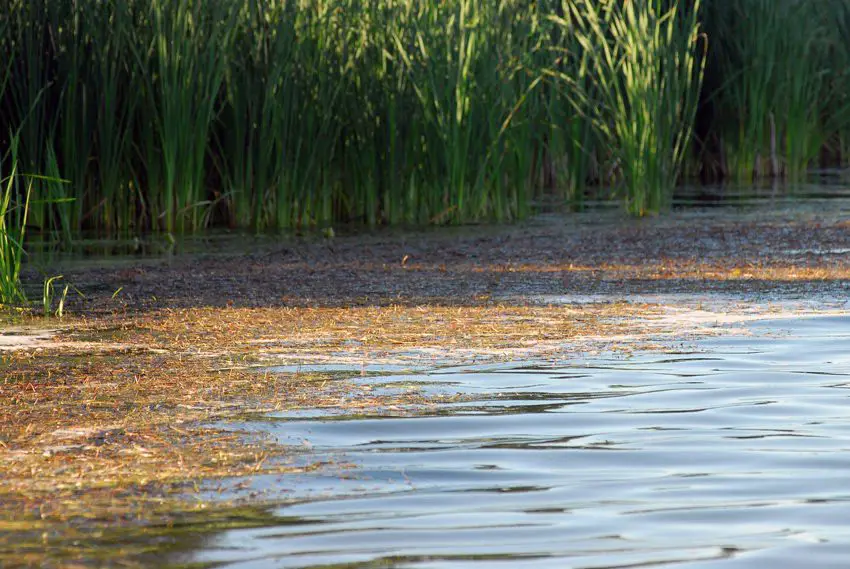
We categorized this differently than weeds, which for the most part are vertical because this cover is totally horizontal. These are dying or dead, detached, and floating weeds.
The reason fish are attracted to dead, matted weeds is because they provide cover directly over the fish. The best part is, all sized fish, including baitfish, love the safety of overhead cover. Unfortunately for those little bait-sized morsels, big mammas know where the buffet line starts.
Largemouth Bass are the main users of matted slop however we have also caught Walleye, Smallmouth and Pike under matts.
CONCLUSION
The terms structure and cover may continue to be misused and garner debate as to what is what but the reality is, both play a major role in a fish’s life, and as anglers, we need to study and understand how to use them to our advantage. So put those polarized glasses on, study your GPS fishing maps, get your transducers pinging in all directions, and look for any or all of our Top 10 suggestions. We guarantee it will up your fishing game to the next level.

Makes Sense